$100 million. That’s the estimated amount it would take for the City of Portland to take over control and ownership of Southeast Powell Boulevard from the State of Oregon. Throw in recommended safety upgrades and the price could rise to between $115 to $185 million. Or if we just opted for a few appetizers instead of the full meal, we could get a significant list of safety projects done for $15-30 million.
That was the menu of options delivered to members of the SE Powell Safety Workgroup on April 26th via a presentation shared by the Oregon Department of Transportation and Portland Bureau of Transportation. The presentation laid out the projects it would take to bring the urban arterial highway (a.k.a. Highway 26) up to a “state of good repair.” That’s the condition PBOT requires before they will agree to a jurisdictional transfer.
Portland advocates and officials have long wanted SE Powell Blvd to come under local control for many of the same reasons that process was recently completed for 82nd Avenue: ODOT has proven to be incapable of managing “orphan highways” in a way that centers human life and neighborhood livability. On 82nd Avenue, the transfer happened after two people were killed by drivers trying to cross the road in separate crashes less than two weeks apart. On Powell, an effort to take the road out of ODOT’s hands was sparked last October after Portlander Sarah Pliner was hit and killed by a right-turning truck driver as she attempted to bike across Powell. That incident, which happened right outside Cleveland High School and a popular park, touched off a wide-ranging effort from a group of advocates, school officials, neighborhood residents, and elected leaders that have met monthly since Pliner’s death.
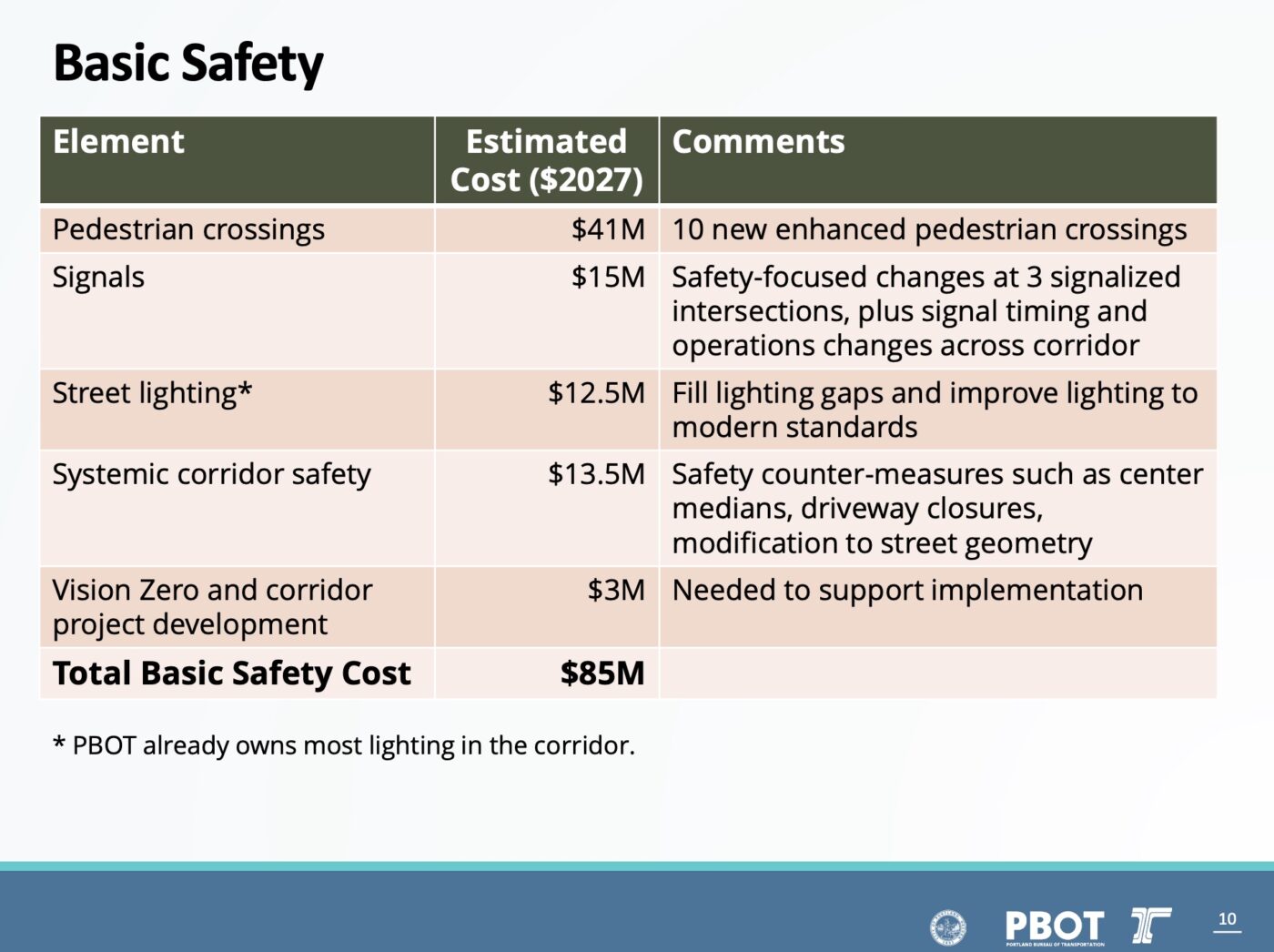
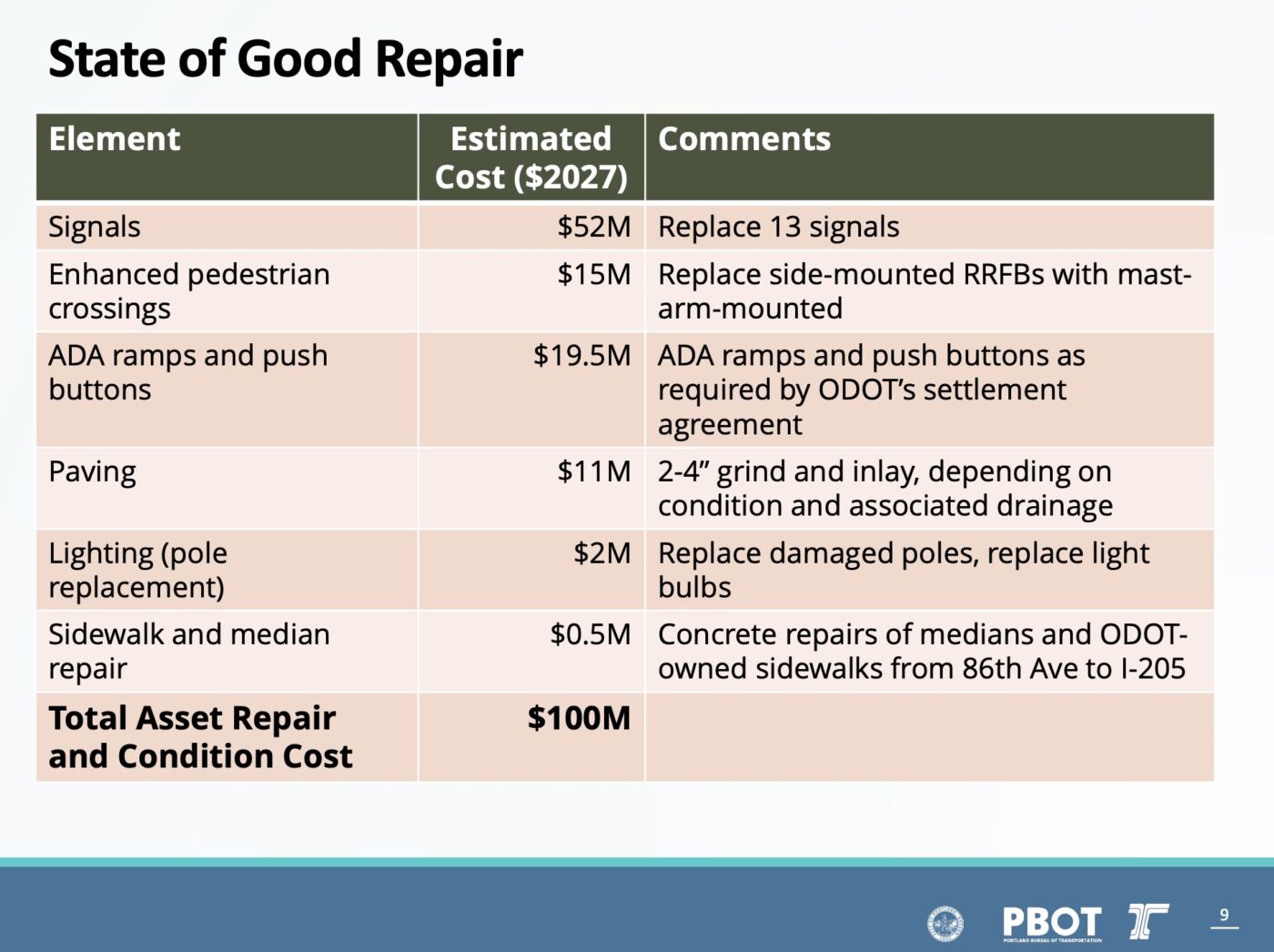

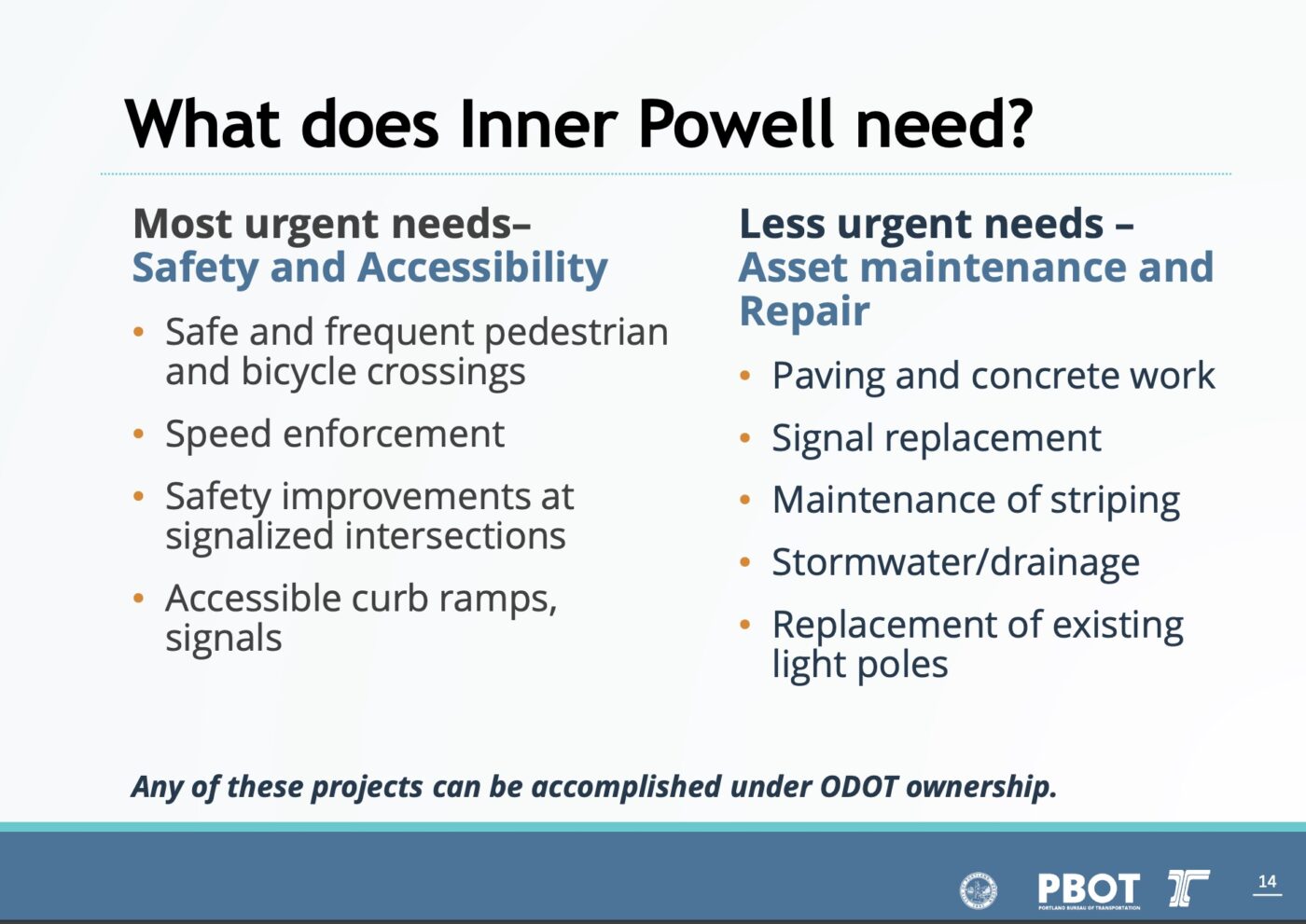
That workgroup has been instrumental in creating the pressure and partnership needed for PBOT and ODOT to make numerous changes to the area around where Pliner was killed. On October 6th, just two days after Pliner died, then PBOT Commissioner Jo Ann Hardesty said, “Enough is enough. The neglect of state-owned ODOT roads within Portland is why we recently brought 82nd Avenue under local control, and we must now begin the process of transferring Southeast Powell Blvd along with funds that cover the true cost of the needed safety improvements all along the boulevard.” Hardesty then brought a resolution to City Council that initiated work with ODOT to, “determine what it would take to improve the street to city and community standards for safety and maintenance for a future jurisdictional transfer.”
Hardesty was not the only one who wanted to switch Powell from state to local control. In 2017, the Oregon Legislature passed a bill (HB 2017) that required ODOT to study the issue. That led to the 2019 State of Good Repair Study that estimated the cost to be around $31 million — less than a third of the current estimate. A report published by Metro in 2020 ranked all potential jurisdictional transfers in the region and Powell was at the top of the list. Like other ODOT highways, Powell has a disproportionate number of serious injury and fatality crashes and there’s a strong consensus that ODOT should stick to managing freeways and leave local roads to local agencies.
Since the push for a safer Powell began back in October, ODOT and PBOT have lowered speed limits, beefed up schools zones, improved crossings, added new signage and pavement markings, and more. But it’s not enough.
Lawmakers who are part of the Safety Workgroup — House representatives Mark Gamba, Khanh Pham, Rob Nosse and Senator Kathleen Taylor — want more. Taylor, who has children at Cleveland High School, has spearhead the effort. After hearing the presentation at the April 26th meeting, she submitted a formal letter (PDF) to the co-chairs of the Joint Committee on Ways and Means saying funding for this Powell transfer was one of her top priorities.
Just two years ago the legislature came up with $80 million for the 82nd Avenue transfer and Taylor and her fellow lawmakers feel their case for Powell is just as strong.
If they don’t get the funding this session, there’s a plan B already in effect. House Bill 2793 (-2 amendment) was filed just two weeks ago by Oregon House Rep. Ben Bowman, a Democrat who represents Tigard and Beaverton. The bill seeks to create a new Jurisdictional Transfer Advisory Committee within ODOT that Nosse says will, “set up a process to stage and vet jurisdictional transfers and set us up to find a source of funding for them.” Bowman is another member of the coalition of legislators who want more local control of ODOT highways and is chief sponsor of HB 2756, a bill that would transfer SW Hall Blvd (OR-141) to the City of Tigard.
(Note: Both HB 2756 and 2793 have a public hearing at the Joint Committee on Transportation tomorrow.)
For their part, ODOT and PBOT say there are some disadvantages to jurisdictional transfer — especially when it comes to Powell Blvd. In their presentation to the Workgroup they said the transfer could slow down the delivery of “most urgent” safety projects because the required and “less urgent” state of good repair projects would focus initially on pavement maintenance and repair projects instead of things like safer bike crossings and speed enforcement. They also issued a warning: “With the City’s current capacity constraints and large capital program, projects on Powell would likely not be delivered until 2030,” the presentation stated. Another point to consider is that once the road is transferred it would no longer be eligible for funding through ODOT’s Great Streets grant program which is only for state-owned highways.
Instead of going straight for the transfer, PBOT and ODOT recommend starting with $15-30 million in safety projects that would include:
- Enhanced pedestrian crossing at SE 36th Ave – $500,000
- Add enhanced pedestrian crossings at existing marked crossings – $3M each (Potential locations include 45th Ave, 54th Ave, between 57th/58th Ave, 61st Ave, 75th Ave, 84th Ave)
- School zone + safe route improvements in Creston area – $3M
- School zone + safe route improvements in Kellogg area – $3M
- Signal timing and ITS improvements – $6M
- School speed zones and safe routes improvements on other state-owned arterials – $3.5M per school for 10 schools located on / adjacent to state highways in Portland
With the budget picture at PBOT abysmal right now and with Senator Taylor and her colleagues’ influence at the legislature, it seems the best bet is that this coalition comes away from the session with funding to get started on these immediate safety projects. Stay tuned.



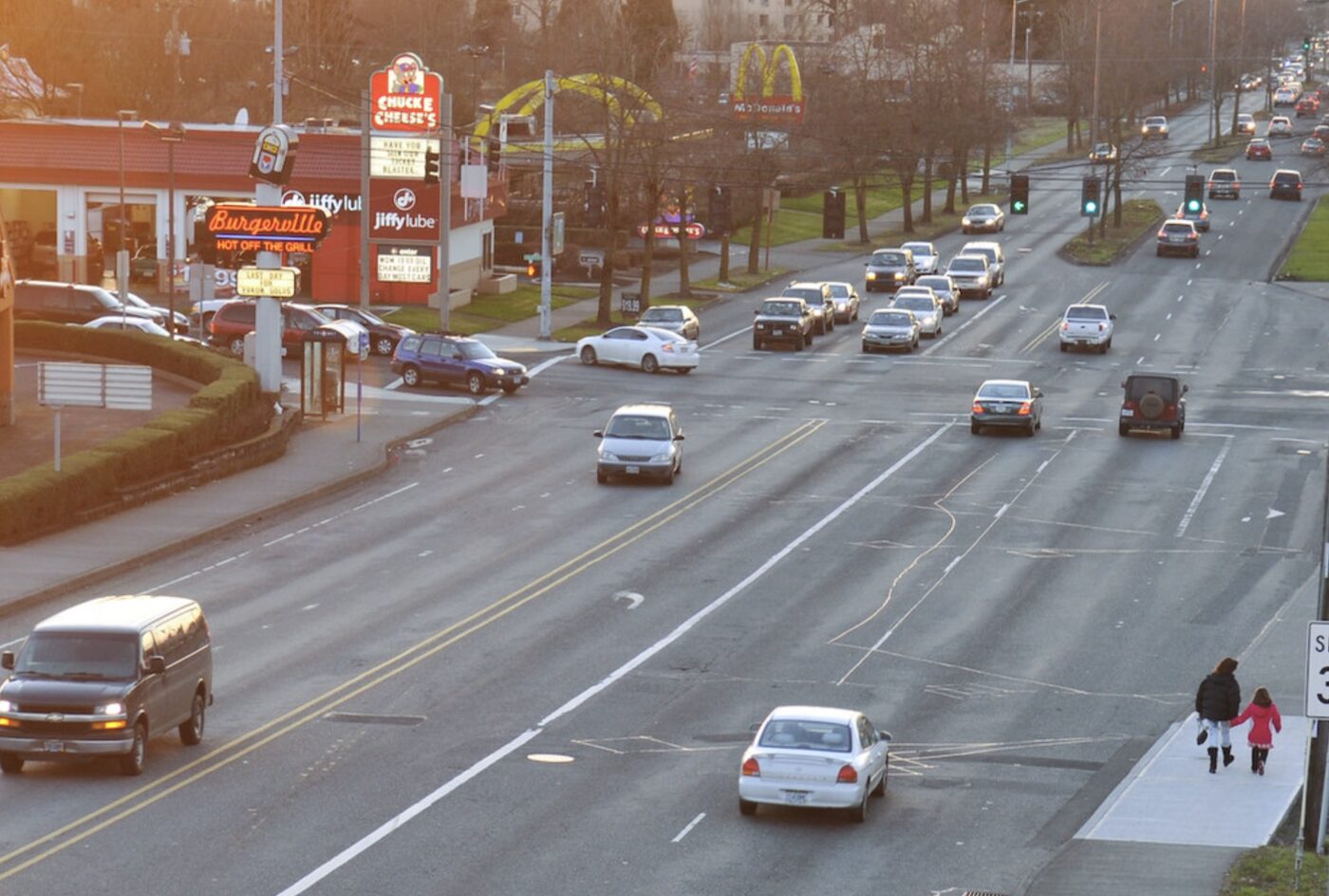

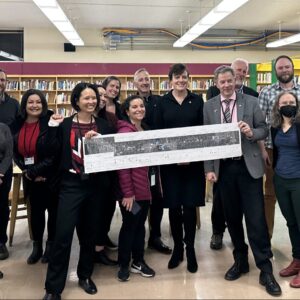
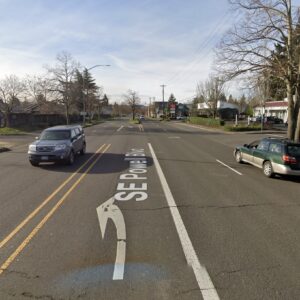
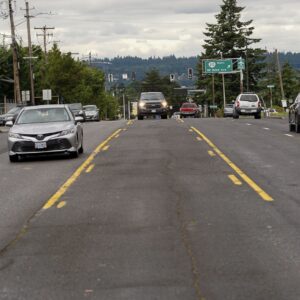

Thanks for reading.
BikePortland has served this community with independent community journalism since 2005. We rely on subscriptions from readers like you to survive. Your financial support is vital in keeping this valuable resource alive and well.
Please subscribe today to strengthen and expand our work.
This seems to be a Portland specific problem. Both Powell and 82nd get safer and are better maintained once you get outside Portland. The cynical side of me thinks it’s because ODOT doesn’t like the city so they choose to focus on other areas (well they like our revenue). The less cynical side thinks it’s probably because the city portions of 82nd and Powell are older so there’s less space and older designs to contend with.
I look forward to any improvement to Powell so hopefully they move forward with something soon. 82nd has already gotten noticeably better.
I can’t speak to it personally, but I heard from staff at the city of Eugene that there was a similar problem with ODOT roads here (of course, sometimes it feels like Oregon politics can be reduced to Portland & Eugene vs the rest of the state). And certainly the formerly ODOT-owned roads are the worst in town. They don’t seem to have gotten any better in the last 5-10 years after jurisdictional transfer, though (Eugene doesn’t seem to have been as good as Portland at extracting value from ODOT), and some seem to have gotten worse under local control (6th & 7th Aves each got an extra lane or two at local initiative, to a maximum of an absurd 5 lanes a piece).
ODOT put all their TLC and $132 million of your money into the 4 miles of Powell east of I-205, which guess what? It’s in Portland too! Amazing!
4 whole miles wow! Out of 20 for just those two roads over how many decades? Ya and it’s still dangerous as all hell. What design is safer this or this? It’s my understanding unprotected left turns are quite dangerous and where are the sidewalks on most of that 4 miles? It’s nice that they paved it but that’s not all I’m talking about. How many people died on those two roads in the last 20 years?
Or maybe they could do it like they did it already at Powell & 128th?
Sounds like a good idea, but I’m waiting to see how things go with 82nd.
It’s such a missed opportunity that, even after traffic to the city center has evaporated into remote work, we are not planning to SUV/truck diet this toxic and deadly traffic sewer.
(A bus rapid transit system on Powell is an absolute no brainer.)
They (ODOT and/or PBOT, don’t remember exactly) will be doing a lane reallocation study for Powell later this year, and I think they might be looking at transit lanes as an option.
ODOT’s antisocial track record makes its “study” of a choice between hyper-individualistic deadly vehicle throughput or public transit suspect. The fact that we are even considering this is a failure.
In the early stages of the planning for what became the Better Division/FX bus line project, there was consideration of where to put BRT first, Division or Powell, and we all know which one won out. I’d be curious to see how ridership has changed on Division with BRT before moving to add it to Powell.
FX is a slow and boring conventional bus line and provides no rationale to wait…but I’m, unfortunately, certain we will wait for our 1950s highway department, dysfunctional quasi-governmental transit agency, and feckless democratic politicians to do the right thing.
The drivers were trying to cross the road? No, I’ll bet the people were trying to cross the road when cars, driven by humans, hit the people.
The Powell Safety Project undertaken a few years ago did not appear to have produced any safety improvement.
My children attended Cleveland High School and I still regularly cross Powell at 26th or 28th Avenue. Virtually every time I go through those intersections, I see cars, usually westbound on Powell, blow through a red light! And speeds are regularly in excess of 40 in spite of the new posted speed.
There should be a red light camera at every intersection.
Until Portland begins enforcing traffic laws, the city should not be seeking to take over jurisdiction of Powell Boulevard or any other roads from ODOT.
Someone needs to drag Trimet into this conversation. I know they have a lot on their plate at the moment. But this is a short four-mile corridor in one of the densest parts of the city, there’s light rail to tie into at both ends, and the ROW is already wide enough for light rail along much of the corridor. Forget the 12-mile line to Tualatin, this should be the priority.
Why build ridiculously expensive new rail infrastructure when we can just repurpose an existing SUV/truck lane to mass transit?
Light rail needs to be dumped in histories ashbin…we have 30 years of evidence it’s basically a little faster than walking…
It’s not a fast or a mass transit system.
If you’re starting near a MAX line, ending near a MAX line, don’t have to transfer, are in the main part of the day, aren’t downtown and nothing shuts down a track …. MAX is great 🙂
OTOH – early AM going from Beaverton to Clackamas – not so much.
On my early morning commute the 2nd fastest/2nd easiest way to go from Beaverton to Clackamas Town Center is to take the Red Line (4:12am) from BTC to Goose Hollow and then ride over to CTC – I arrive at Sunnyside and 205 about 5:05-5:10. Doing that by MAX (Red Line to Gateway, Green Line down) you’ll still be waiting at Gateway for your connection.
That’s a pretty special circumstance though – the connection at that time is awful (21minutes) and you go a long way north before going south.
I have (on occasion) raced the Orange line from 5th and Columbia to Main st. in Milwaukie and tied (literally saw it on 5th as I dropped down then rode underneath it on the Main St. platform).
Again, special circumstances (half that time for the Orange Line is getting to OMSI and I *literally* rode that without having to even touch the brakes)
“If you’re starting near a MAX line, ending near a MAX line, don’t have to transfer, are in the main part of the day, aren’t downtown and nothing shuts down a track …. MAX is great”
Max embodies a transportation paradigm developed in the 19th century. It’s hardly surprising that most people find point-to-point on-demand options to be much preferable, even when they are more expensive and come with significant frustrations.
Absolutely untrue. Average travel time is faster than the bus, and it can carry 4-5 times the riders per operator.. Saying that it’s barely faster than walking is just nonsense.
A line on Powell would have very high ridership, and would make the entire system more resiliant, as it removes the Steel Bridge single-point failure. The construction right now is a perfect example. Red and Green trains are terminating at Gateway TC right now. If we had a line on Powell, they could be continuing into downtown via the Tillicum Crossing.
Obvious my walking analogy was just sarcasm but the average speed is 13-14 mph.
Would a dedicated bus not be faster and cost a LOT less.
Or a “train of busses? Why expensive tracks?
I see the Milwaukee light rail train mostly empty most of the time.
Was that a good use of Transportation funds?
The right-of-way is the expensive part. Creating dedicated corridors with minimal conflict with cars and trucks is expensive. Tracks and cantenary add more cost, of course, but LRT has significantly lower operating costs per rider. It’s a trade-off between up-front capital and long-term operating costs. IMO, some of the MAX segments do not achieve this level of ridership (Interstate and I-205 segments), but the remainder of the system does.
Hindsight is always 20/20. If we hadn’t had Covid and the associated vacating of downtown and collapse of transit ridership, it would be a lot easier to defend mass transit, and transit in general. With our current ridership level, the billions we spent on HCT corridors is looking like a huge waste. Who knows what ridership will be a decade from now, though.
And yes, maybe Portland should have built a concrete BRT corridor along the Banfield freeway back in the 80s. But would they have? More than likely, they would have just widened the freeway and added carpool lanes, and our HCT spine on the east side would be busses stuck in traffic. And that’s the main issue with BRT. It’s always cheaper up front, but it’s also incredibly easy to make trade-offs and water-down the corridor. What would Portland look like if we have 10 different FX-type services on our major corridors and no MAX lines? Would ridership be higher or lower?
TriMet is in the conversation, although maybe not exactly in the way you mean. They’ve had a representative at all the safety workgroup meetings, are planning changes to stops/lines to make it safer for students taking the bus to Cleveland, and have planned crossing improvements at Cesar Chavez, 47th, 57th, 61st, 79th, and 82nd.
I’ve been following these conversations since the beginning of bikeportland. It seems worth pointing out that regardless of which bureaucracy oversees this (PBOT, ODOT) the taxpayers will fund whatever improvements are agreed to. And we here in Portland are funding both PBOT and I have reason to believe a goodly share of ODOT as well.
I have also never understood why the language around these transfers essentially capitulates to *ODOT can’t be trusted to do a decent job with these highways*. Why not?! What is wrong with our accountability systems that this would be so?
State departments of transportation are generally less willing to experiment with “new” or experimental roadway designs, and are more bound to their highway design manuals. This is still true, but ODOT has a new manual, the “Blueprint for Urban Design,” which allows them to build in more context-sensitive ways, rather than applying the same standards to urban highways that they apply to rural ones. By following the BUD, ODOT would be able to build something much closer to what PBOT would do, which they wouldn’t have been able to do in the past. Even with the BUD though, ODOT has some big trust issues to work through.
We know what these “orphan highways” need, but transferring them from ODOT to PBOT isn’t exactly putting them into the hands of a bureau known for being a steward of any assets larger than a sweeper.
Powell has seen its “climax” as an automobile-oriented street, but building for the future is still delicate work. Plan all you want, but the future is never what it used to be.
Why are they stopping at 84th? Powell gets increasingly unsafe the further East you travel. The road narrows. The bike lane is basically a shared shoulder lane for parked cars, pedestrians and for bikes. I suppose that’s a larger statement on how the City of Portland views those that live further from the Downtown area.
There was already a project dedicated to making east powell more safe https://www.oregon.gov/odot/projects/pages/project-details.aspx?project=21178.
They are stopping at I-205, not 84th. East of I-205 safety improvements have already been partially constructed (from 122nd to 136th) and the rest of it is slated for construction later this year: https://www.oregon.gov/odot/projects/pages/project-details.aspx?project=21178
I know it cliched, and even a bit naïve, to criticize the price tags of these improvements, but they are begging for it. Just looking at the first one I read: $41 Million for 10 Enhance Crossings. $4 Million each!!!!
Again, not trying to be totally out of sync with reality here, but these are basically some cement work for an island, and some button activated crossing signs, right? And yeah, you need people to divert traffic during install, and hook up the electric part…. But still!!
They are fully-signalized crossing, and yes they do cost that much. Inflation is real!
Silky is absolutely correct this is just bloated spending.
I am sure you city apologists can find some flat tax that can fund this.
Low income people can fund this with some new city tax.
13 signal replacement at $4million each? 10 enhance pedestrian crossings at $4.1million each? Safety focused changes at 3 intersections for $5million each? what kind of organized crime ring is Strickler operating?
Can we dig a little deeper as to why it will cost us $6 million to time the traffic signals?
Maybe now that I-205 expansion is not going to happen, How about ODOT pay for some of these urgently needed elements to move the transfer along…